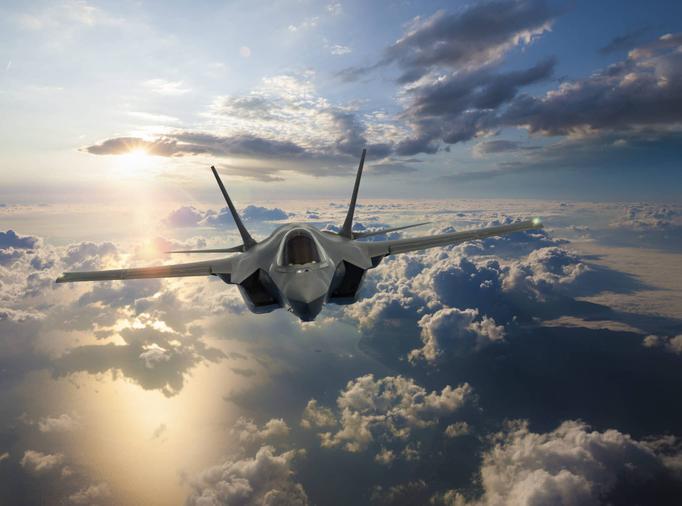The first operational F-35 is delivered to Eglin Air Force Base, Fla., on July 14, 2011. (Samuel King Jr./US Air Force)
WASHINGTON: On Friday, Oct. 26, 2001, executives and employees from the nation’s two biggest defense primes gathered in boardrooms and sprawling production facilities to watch a Pentagon press conference. At stake: the Joint Strike Fighter competition, which would decide who would dominate the next 40 years of the defense aerospace industry — and rake in hundreds of billions in profits.
It was a moment five years in the making. The Pentagon wanted to buy a single stealth aircraft for the Air Force, Navy and Marine Corps capable of three distinct operational requirements: conventional landings on a runway, landing on aircraft carriers, and performing short takeoffs and vertical landings.
It awarded contracts to Lockheed Martin and Boeing in 1996 to build competing prototypes, known as the X-35 and X-32. By July 2001, Lockheed’s X-35 had proven it could execute a short, 500-foot takeoff, fly at supersonic speeds and then vertically land in a single flight. While Boeing’s X-32 also demonstrated supersonic flight and vertical landings, it did not accomplish them in the same flight.
For the engineers that had designed and developed the two planes, emotions were running high as a group of white-haired defense acquisition officials approached the podium of the Pentagon press briefing room.
And just like that, the competition was over.
After a few minutes of opening comments, Air Force Secretary Jim Roche announced the Lockheed proposal “emerged continuously as the clear winner” with “few weaknesses” and a lower level of technical risk.
“Both proposals were very good, both demo programs were very good. But on the basis of strengths, weaknesses, and degrees of risk of the program, it is our conclusion…that the Lockheed Martin team is the winner of the Joint Strike Fighter program on a best value basis.”
At Lockheed’s Martin’s production facilities in Fort Worth, employees watching the press conference erupted into cheers.
“[Roche] got ‘Lock-’ out, and that was the last thing I heard because everybody jumped up and started yelling and clapping,” said Tom Burbage, then the executive vice president of Lockheed’s JSF program.
During the press conference, Edward “Pete” Aldridge — then the Pentagon’s undersecretary of defense for acquisition, technology and logistics — characterized the joint strike fighter as a “highly common, lethal, survivable, supportable and affordable next-generation multi-role strike fighter aircraft.”
F-35 development and production was valued at about $200 billion at the time, with at least 3,000 aircraft purchased over the program of record. Roche projected that each aircraft would cost anywhere from $40 million to $50 million depending on the variant, in 2001 dollars (about $62 million to $77 million today). The first production model F-35 would be delivered in 2008, Lockheed stated.
However, for the Pentagon, the dream of the F-35 all too often felt a little like a nightmare.
Technical problems discovered in the early years of development caused ballooning cost growth, ultimately triggering a Nunn-McCurdy breach in 2010 that led to the program being restructured. Lockheed wasn’t able to deliver the first production model F-35 until 2011. Relations between Lockheed and the Joint Program Office hit a nadir in 2012 before slowly being repaired.
Twenty years after its initial contract award, the Defense Department predicts that it will cost $398 billion to acquire the planned F-35 fleet, with the total lifecycle cost of the program pegged at $1.7 trillion — overruns that have led the F-35 to became the poster example of what current Air Force Secretary Frank Kendall termed “acquisition malpractice” in 2012.
Yet ultimately, Lockheed succeeded in building a fifth-generation aircraft that could be used by the Air Force, Navy and Marine Corps, and has won every international sales competition it has been in. For all the technological problems the aircraft has faced over its development, pilots have been enthusiastic about the benefits its combination of stealth and data fusion bring to the battlefield.
Airman 1st Class Allison Lasher, 33rd Aircraft Maintenance Squadron crew chief, marshals Lt. Col. Christine Mau, 33rd Operations Group deputy commander, as she prepares to take off for her first flight on Eglin Air Force Base in 2015. (Staff Sgt. Marleah Robertson/US Air Force)
The Marine Corps was the first to introduce the F-35 in operations in 2015, followed by the Air Force in 2016 and the Navy in 2019. In May 2018, the Israeli air force became the first organization to fly the F-35 in combat, beating the US military to the punch. US Marine Corps F-35Bs conducted its first combat mission in Afghanistan later that year, and the Air Force F-35As later spent 16 months deployed to the Middle East.
And though sustainment costs remain a threat to the program’s health, the cost of producing the most widely used variant, the F-35A, has fallen to about $78 million per copy — short of the Pentagon’s goal, but still on par with a high-end fourth generation fighter.
“The idea of combining a conventional takeoff, carrier based and a short takeoff vertical landing plane, all in one airframe, looked daft from the start and should have failed. But it didn’t because of tens of billions of dollars pumped into it,” said Richard Aboulafia, an aerospace analyst for the Teal Group.
The takeaway from the last 20 years, he noted, might well be “You succeeded, but please don’t try that again.”
‘A Last Fighter’
In 2001, the loss seemed existential for Boeing.
“We were all crushed,” said Todd Blecher, a former Boeing spokesman who was assigned to the JSF program and watched the Oct. 26 announcement from the company’s combat aircraft production facilities in St. Louis, Mo.
The company had planned for Mike Heinz, Boeing’s deputy program manager for the X-32, to brief local media in St. Louis, accompanied by a handful of engineers, after the contract announcement was made, Blecher said. While Boeing’s communications team urged the other employees to allow Heinz to speak to the media alone, they declined the reprieve.
The Boeing X-32A being towed to a restoration building at the National Museum of the U.S. Air Force on Nov. 20, 2016. (Ken LaRock/US Air Force)
“All those employees, who we had prepared to come out and celebrate in front of the local media, now … had to answer, repeatedly, that question of how does it feel [to lose],” he said. “They were crying in their team jackets and everything. It was a very sullen, solemn atmosphere, but God bless them, they did it.”
Much of the media coverage in the immediate aftermath of the JSF contract announcement centered on the department’s “winner takes all” acquisition strategy, which left Boeing completely cut out of the program.
“The two teams formed under the assumption that they were out to win the contract. They worked very very hard, they put a tremendous amount of investment into their team activities,” Aldridge said during the press conference. “It would seem to be somewhat unfair to tell the winner, you must now absorb the loser after you’ve formed your team.”
Boeing was facing 30,000 layoffs in its commercial division, The New York Times reported at the time, and congressional backers raised concerns about whether the company would be able to retain its ability to manufacture fighter jets after the Navy finished F/A-18E/F Super Hornet procurement in the early 2010s — or whether it would survive the decision at all.
RELATED: F-35 Engine Rivals Prepare For Another Clash
Analysts at the time predicted that Boeing might be able to recoup the loss because of ongoing work on armed unmanned systems, which they projected would become a massive business. However — aside from support of the General Atomics MQ-1 Predator and its successor, the MQ-9 Reaper — programs of record for combat drones never materialized.
With so many fighters set to be replaced by a single aircraft type, the underlying message to industry was, “Well, would you like a Last Fighter to go with your Last Supper?” Aboulafia said, referring to a 1993 event where Deputy Defense Secretary Bill Perry invited defense CEOs to dinner and instructed them to merge their businesses.

The JSF was conceptualized before the wars in Afghanistan and Iraq led to a hike in defense budgets, and before China emerged as a major military power. Aboulafia described the atmosphere as “a vaguely apocalyptic post-Cold War defense contracting environment” where contractors were concerned about dwindling defense spending and consolidation.
Some 20 years later, Lockheed’s F-35 has secured a formidable number of international sales, adding Belgium, Singapore, Poland and Switzerland to its list of customers over the past few years. The Pentagon remains committed, at least on paper, to a planned buy of2,456 F-35s.
However, fears that the F-35 would become the Last Fighter have not borne out. There continues to be a healthy market for fourth-generation aircraft. France’s Dassault Rafale and Saab’s Gripen E continue to nab international orders, while the US Navy never stopped buying Boeing’s Super Hornet. The US Air Force itself in 2020 placed an order for the new F-15EX variant, denying Lockheed total control of the fighter market.
If anything, the F-35s long development timeline has taken its toll on the program itself. Although none of the US services have formally reduced their planned buy, the Air Force is now considering whether it should buy fewer F-35s and replace a portion of its F-16 fleet with a lower cost fourth-generation fighter. Meanwhile, the Marine Corps is evaluating changes to its fighter squadrons that could result in the service buying 54 fewer F-35Bs.
“[The JSF contract] obviously gave Lockheed Martin unquestioned global dominance of the fighter market. But it certainly didn’t hand them a monopoly either at home or abroad,” Aboulafia said.
“Anyone that thought, 20 years later, the F-15 and F/A-18E/F would still be in full production and [that Boeing would] have successfully bid on new military aircraft, I don’t think anyone would have believed you.”
Some analysts predicted that the JSF award would lead to additional mergers among the Pentagon’s major aircraft suppliers, but its three major aerospace companies — Lockheed, Boeing, and Northrop Grumman — remain among the most powerful and lucrative defense primes.
While consolidation in the defense industry has continued — among notable moves are Raytheon absorbing United Technologies Corp, Northrop’s purchase of Orbital ATK, and Lockheed currently angling to acquire Aerojet Rocketdyne — the F-35 program cannot be seen as a root cause, said Byron Callan, an analyst with Capital Alpha Partners.
However, it could also be argued that the Defense Department has had to manage the industrial base differently simply because it didn’t want to lose Boeing as a fighter manufacturer, said Roman Schweizer, a defense analyst with Cowen Research.
“Was it an industrial base decision” to award programs like the Air Force’s T-X training jet competition to Boeing, thus “making sure that engineers and production workers across the industry have programs to be working on?” Schweizer asked. When it came to awarding new-start programs, “it seems like there’s been thoughtful decisions about what the industrial impact is.”
“It’s a complex equation,” Schweizer said. “There’s a lot of right answers, and unfortunately there’s a lot of wrong answers, too.”
Learn Your Lessons Well
Although the Joint Strike Fighter contract award may have not resulted in the complete upheaval of the defense aerospace industry, analysts said its impact has rippled through the world of defense contracting — and that the lessons may reverberate years after F-35 procurement comes to a close.
Perhaps the most obvious lesson from the program, analysts agreed, is to forgo joint programs for major weapons systems, reducing the program’s complexity by having fewer competing requirements.
In the future, “you’re probably going to see requirements and acquisition strategies for big programs that aren’t so ambitious from a jointness perspective … and also acquisition strategies that don’t have such long term industrial repercussions,” Schweizer said.
One example is the Navy and Air Forces sixth-generation fighter programs. Although both are named “Next Generation Air Dominance,” the efforts are not related.
Software is another area the JSF program has left its mark, said Bill Greenwalt, who worked as deputy defense undersecretary for industrial policy during the later years of the Bush administration.
The F-35 was the first fighter where software was a major feature of the aircraft, with more than 8 million lines of code that allowed it to fuse data and imagery across its different sensor suites and share it with other F-35s flying in formation.
Two U.S. Marine Corps F-35B Lightning II’s assigned to the Marine Fighter Attack Squadron 211, 13th Marine Expeditionary Unit, fly a combat mission over Afghanistan, Sept. 27, 2018. (Staff Sgt. Corey Hook/US Air Force)
The Pentagon recognizes that it must be able to update the F-35 and future aircraft with new batches of software code, even if it has struggled to match the pace seen in the commercial world. Future fighters will likely be designed with even more of a focus on software development, Greenwalt said.
“These are flying pieces of software, and the ability in the contracting world to bring in new software developers — there is an entirely new industrial base that’s available now,” he said.
The industrial fallout of the “winner takes all” contract decision — combined with the F-35’s cost overruns and schedule delays — could also prompt the Pentagon to prioritize ongoing competition throughout the lifecycle of a future fighter, analysts said.
“With another future program of this size, do they really want to be sole-source?” Callan asked, adding that Lockheed’s control over the F-35 technical data has made it difficult for the department to outsource elements of the program where Lockheed has not performed.
“People are going to think very differently about the information systems architecture. A future platform is going to be an open architecture,” he said. “The other part is, DoD is going to want to have more control over data rights and own the technical baseline so they can compete” aspects of the program throughout its lifecycle.
Greenwalt argued that the Pentagon should have continued prototyping aircraft with both vendors until the design was production-ready, keeping Boeing and Lockheed in a “tight competition” and allowing both to iterate on fighter jet designs.
Legislation that granted the department more flexibility to acquire systems through serial prototyping —such as section 804 mid-tier acquisition authorities — could be seen as Congress’ effort to ensure more competition continues throughout technology development, he said. However, it remains to be seen whether the department fully embraces these new tools, or whether Congress will continue to reform the acquisition process to allow the Pentagon to change course when technologies fail.
“One of the biggest reasons why we’re going to lose to China is the inability to have flexible budgeting to compete when things don’t go the way they’re predicted,” Greenwalt said. “And guess what? They never go the way they’re predicted.”
Twenty years after its initial contract award —and even as F-35 production numbers more than a hundred planes per year — the Joint Strike Fighter program technically still remains in development due to delays in finishing up operational testing.
An F-35B jump jet practices vertical landing at Marine Corps Air Station Yuma.
The Pentagon planned to issue a “Milestone C” declaration to begin full-rate production in 2019, but as of an Oct. 13 meeting of the defense acquisition board, a revised schedule for the milestone has not been approved.
This long timeline, Greenwalt said, is a paradigm the Defense Department cannot afford to repeat if it wants to compete with the rapid technological advances of China.
“The Chinese are deploying capabilities, whether it’s missile capabilities, or aircraft capabilities…. in two to four year increments,” Greenwalt said. “In the future, we can’t develop an aircraft like this that takes 25 years to develop.”
Networks / Cyber, SponsoredBuilding Multi-Cloud in the Intelligence Community
Networks / Cyber, SponsoredBuilding Multi-Cloud in the Intelligence Community
Networks / Cyber, SponsoredBuilding Multi-Cloud in the Intelligence Community
Information superiority and speed to mission are the hallmark of multi-cloud environments, along with automation, cybersecurity, and governance.
FromBreaking DefenseInformation superiority and speed to mission are the hallmark of multi-cloud environments, along with automation, cybersecurity, and governance.
FromBreaking DefenseRecommendedNew Air Force One could face ‘quite a significant’ 3-year delay
The major driver of the delay is the bankruptcy of GDC Technics, Boeing’s original subcontractor for the VC-25B’s interiors, and the hiring of a new interior supplier, said Andrew Hunter, the Air Force’s assistant secretary for acquisition, technology and logistics.
ByValerie Insinna









